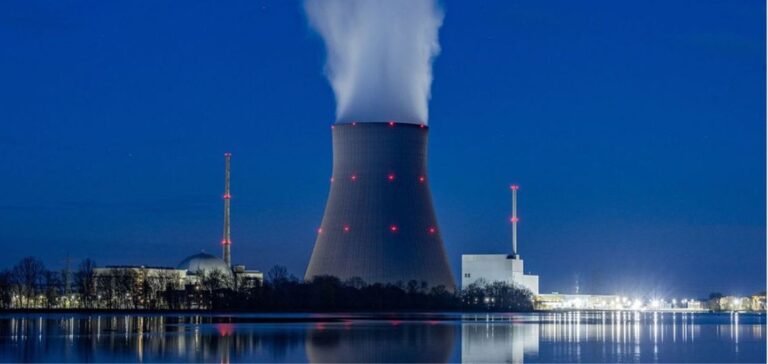After German reunification, Hartmut Schindel did not bet much on his future at the nuclear power plant in Lubmin on the Baltic Sea, which had just been closed.
But 33 years later, Hartmut is still there and so is the power plant, or at least what remains of it after the various phases of its dismantling, which is still only halfway through. “We were sure we were going to be gotten rid of,” recalls this employee who started out as an apprentice at what was once the largest nuclear facility in East Germany.
Five reactors to dismantle, 1.8 million tons of potentially radioactive material to decontaminate… The titanic construction site, launched in 1995, still employs some 900 people. “We are very careful, and of course it takes time,” says Hartmut Schindel, who has moved from nuclear waste management to communications functions. This is the long road ahead for Germany’s last three active nuclear power plants, which will cease operation for good on Saturday.
Giant saws
In the site’s central workshop, a constant din envelops the workers, dressed in overalls and helmets. They cut, compress and purify steel blocks or cable bundles with a whole arsenal: a 1,200-degree flashlight, an XXL metal saw or an ultra-high pressure water jet.
The materials are then stored in standardized pallets of 120 by 80 centimeters. The radioactive residues are stored in another hall, where huge red, yellow and blue containers stand. Entire sections of the plant are slowly being eroded at a rate of 600 tons per year.
In the 5 reactors, active between 1973 and 1990, some components continue to emit high dose radiation. “In order to dismantle them safely, a special building had to be constructed, which will be ready by 2025,” explains Kurt Radloff, spokesman for the EWN Group in charge of the construction. The most radioactive components will be immersed in water and dismantled remotely, “a flagship technique” that could inspire the dismantling of other plants, he said.
The question of disposal is more difficult, as Germany does not yet have a disposal facility for high-level radioactive waste. Not to mention the challenge of recycling, as 98% of the materials, once decontaminated, can be recycled after meticulous checks. The oldest nuclear decommissioning site in Germany, the Lubmin plant -also known as the Greifswald plant- in northern Germany is also a special case.
The costs of dismantling were skyrocketing, the delays were accumulating. It will take another 30 years to complete the work. “At first we thought it would be over by 2030,” says Christian von Hirschhausen, an expert at the DIW economic institute. “You also learn as you go, by undoing the plant,” concedes Kurt Radloff.
“Thank you. No contamination.”
In addition to the size of this site, the East German type of power plants are “more complex” to deconstruct, according to the economist, particularly because of data lost at the time of reunification. “The plant was built for eternity,” recalls Hartmut Schindel, who will soon retire.
Security reasons were given for closing Lubmin after the fall of the Wall. About twenty other reactors, closed in recent years, are being dismantled in Germany for periods that should be shorter. Every day, most of the employees mechanically follow a heavy procedure, between airlocks, successive undressing and scanning in narrow capsules. Inside these, one complies with the orders of a robotic voice straight from the 1980’s, until it resounds: “thank you. No contamination”.
The radioactivity tests also apply to each pallet that leaves the site. If the light is red, it’s back to decontamination. Even the journalists’ cameras, batteries, etc. are not spared from this examination, which can last up to 40 minutes.
An unusual image in this drastically secured environment: a local tennis club trains on a court nestled at the very top of the old Block 6, a reactor that was never put into service and has long since been converted.






















